
Chevrolet Corvette Owner Manual (Holden-Localizing-Australia/New Zealand-
15749882) - 2022 - CRC - 9/20/21
158
Driving and Operating
Caution
Overloading the vehicle may cause
damage. Repairs would not be covered by
the vehicle warranty. Do not overload the
vehicle.
{
Warning
Things you put inside your vehicle
can strike and injure people in a
sudden stop or turn, or in a crash.
.
Put things in the rear area of your
vehicle. Try to spread the weight
evenly.
.
Never stack heavier things, like
suitcases, inside the vehicle so
that some of them are above the
tops of the seats.
.
Do not leave an unsecured child
restraint in your vehicle.
.
When you carry something inside
the vehicle, secure it whenever
you can.
Starting and Operating
New Vehicle Running-in
Follow these recommended guidelines
during the first 2 414 km (1,500 mi) of
driving this vehicle. Parts have a break-in
period and performance will be better in the
long run.
During the first 800 km (500 mi), engine
torque will be limited in low gears.
For the first 322 km (200 mi):
.
To break in new tyres, drive at moderate
speeds and avoid hard cornering.
.
New brake linings also need a break-in
period. Avoid making hard stops. This is
recommended every time brake linings
are replaced.
For the first 800 km (500 mi):
.
Avoid full throttle starts and abrupt stops.
.
Do not exceed 4000 rpm.
.
Avoid driving at any one constant speed,
fast or slow, including the use of cruise
control.
.
Avoid downshifting to brake or slow the
vehicle when the engine speed will
exceed 4000 rpm.
.
Do not let the engine labour. Never lug
the engine. This rule applies at all times,
not just during the break-in period.
For the first 2 414 km (1,500 mi):
.
Do not participate in track events, sport
driving schools, or similar activities.
.
Check engine oil with every refuelling and
add if necessary. Oil and fuel
consumption may be higher than normal.
Front Air Dam (and Splitter)
If equipped, the front air dam and splitter
have minimal ground clearance.
Under normal operation, the components
will occasionally contact some road surfaces
(speed bumps, driveway ramps, etc.). This
can be heard inside the vehicle as a scraping
noise. This is normal and does not indicate a
problem.
Use care when approaching bumps or
objects on road surfaces and avoid them
when possible.
If equipped, the Front Lift System may be
used to increase front air dam or splitter
clearance. See
















































